There are three stories to tell:
Incident #1: Lebanon
A nice Druze woman on a bus in the Chouf mountains in Lebanon told me her favorite fruit was Persian aprict–mishmish ajami. She said it stayed green, and was both sweet and sour, and was not very fuzzy.
Sadly, I was scheduled to leave Lebanon just a couple of days later, and had no time to look for this fantastic fruit.
In lieu of a picture of that fruit, or of that woman, here at least is a nice photo of Peter with a Druze man.
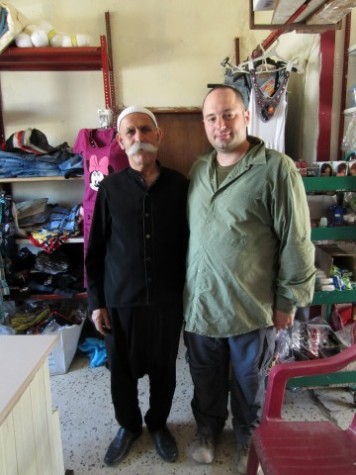
Incident #2: Greece
After the fantastic ladies at our favorite restaurant in Eressos showed us how to make Easter lamb, they pointed to a crate of fruit and told us to help ourselves.
They called the fruit milorodaxino–literally, “apple peach.” From far away, all piled in the crate, the fruit did look like kind of crappy little Golden Delicious apples. Up close, though…best nectarine ever:
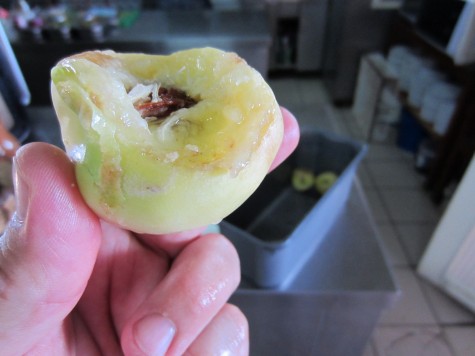
And, as you can see, green all the way through.
Was this the phantom Persian apricot, by another name? The farmer who grew the fruit was there outside the restaurant, all burly forearms like Popeye and a mustache to beat the band. He was the only one that grew this fruit, he said. End of story.
Incident #3: Astoria, New York
When we returned to NYC, one of the 24-hour produce stores (yes, we have more than one) had these “honeydew nectarines” in stock:
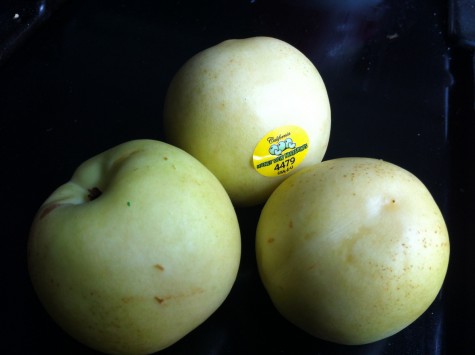
They looked the same, but they were kinda crappy–a little mealy, not intense flavor. The woman who runs the store admitted they were not at their best. It was hard to tell whether it was not the same fruit at all, or just a typically poor American rendition of it.
And because she’s Greek, Peter asked her if she knew if these were the same as the milorodaxino. No, no, she said–those are part apple, and these were part melon.
Er, I think she’s wrong on both counts, because that would be like serious fruit miscegenation, so unfortunately I have to discount her as an unreliable source. But I appreciate that she makes an effort to source new and interesting fruits and veg–we also got these neat bulbous cucumbers from her, and some great liver-colored heirloom tomatoes.
Second data point: After writing all this, I flipped over an old issue of Cook’s Illustrated, and it had an illustration of peaches and nectarines. The Honeydew variety was on there. The issue was from 2002–so this isn’t a new strain.
Further data point: Turkey
Check out these marzipan fruits in a storefront in Istanbul. A couple of them look like they could be the mysterious fruit.
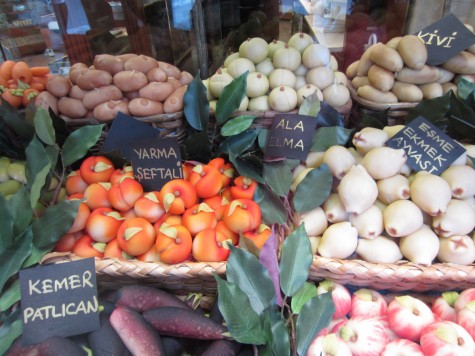
Ala elma = “ala apple” according to Google translate, which is maybe just the variety name of an apple, like Gala?
Or this one:
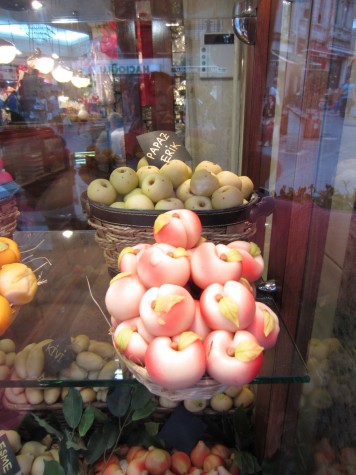
Papaz erik = “pastor plum”
Obviously, the fact that these were rendered in marzipan makes it especially difficult. In retrospect, Peter and I should’ve gone to the adjacent market and looked for the real-fruit equivalents, instead of getting distracted by an antiques store.
So gardeners, travelers, botanists, Lebanese fruit-lovers: tell me what you know. Have you eaten any of these things? Are they all the same? Are they different?
Bottom line, really, is: Did I miss the Best Fruit Ever by not getting those mishmish ajami in Lebanon in the first place?
(If you like stories about cross-cultural plant identification, also check out my old story about purslane[PDF]. That one took years to solve. Now that the internet is more full of information, I expect to solve this question in minutes. Right? Hello? Anyone?)
Do marzipan fruits all taste like almond paste?
Sadly, I think so. I gave up tasting them years ago. But for all I know, Turkey is such a land of wonders, they might have exotic-flavored marzipan fruits somehow, and I’ve just been missing out.
Slightly related: When we were in Edirne, in Turkey, the city specialty is soap shaped like fruit. It’s very convincing. But seems like a nasty trick in a region where marzipan fruits are already established!
Okay, I’ll my best here.
First, the Persian apricot. As that area of the world is closer to the home of the original apricot, apparently there is still quite a bit of genetic diversity. A few famous strains of white Persian apricot exist. Through USDA GRIN, researchers and home-experimenters are able to order scionwood for these varieties, and a few commercial sources of trees have them available too. I have not tasted one. Though I know people who’ve tried growing the scionwood, apparently my region world has winters that are too warm to signal the trees to fruit.
By looking at the next fruit in the picture, I think you have a nectarine/peach (same species) there, and not an apricot. Apricot pits are smoother and less ridged than nectarine/peach pits. That pit looks like a nectarine/peach pit. The old, old, old versions of white nectarines and peaches had green flesh and skin, just as we can see in your picture. (Breeders had bred for a clear white rather than green white in the past couple centuries to increase fruit sales: green fruit looks sour, even when it isn’t, and is harder to sell.) Also characteristic of old strains of white peaches and nectarines is what I think of as a “flash of bitter.” I don’t mean sour, I mean bitter, but in the best way that balances all that crazy-good sweetness. The man who raised the fruit very well may be the only one who grows that fruit–he may be the last one who grows that particular variety.
Honeydew nectarines–not their patented name, just a sales name, similar to the “mango nectarine”–can be a variety of relatively new (last couple decades) crosses between a few really old (read green-skinned, greenish-white fleshed) varieties. They can be good; they can be bad. Well-ripened on the tree, they’re usually pretty darned good.
Okay, that is what I know. I’m sure that there are people out there who can answer this question better. Whatever you ate, it looks good, and I’m jealous. Yes, good fruit makes me jealous.
Er, I’ll _do_ my best. Edit, Wenger, edit!
Hmm, I envy this tart apple-apricot, but don’t know of anything Turkish that resembles it. The “papaz erik” is essentially a tiny, unripe plum, more akin to a Granny Smith apple than anything sweet. Turks are crazy for them and eat them by the sackful, but I think there is a reason we were taught not to eat green fruit – it’s not ripe yet! Can’t help you with the Ala Elma, have never seen such an apple in Turkey.
Thanks a million, Christina! Very interesting about the green being bred out in favor of white, and fascinating about the bitter flavor. I guess that’s an effect of something in the pit leeching out more? I didn’t really sense any of that in the milorodaxino, though.
(And a-ha–of course that’s a nectarine-y thing! Totally forgot about how apricot pits look.)
Meg, I know the plums you’re talking about. They eat them in Lebanon and Syria too, where they’re called janarik, which I guess is from Turkish. (Cani–new; erik–plum?). Some people sprinkle salt on them. They’re very bracing! In Lebanon in particular, they’re crazy for sour, so they fit right in–they come out at the same time as the green almonds. I’ve also had stuffed grape leaves in Syria where they were stewed with janarik for sourness, because it wasn’t the season for lemons.